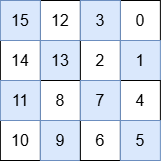Description
You are given a non-negative integer n representing a 2n x 2n grid. You must fill the grid with integers from 0 to 22n - 1 to make it special. A grid is special if it satisfies all the following conditions:
- All numbers in the top-right quadrant are smaller than those in the bottom-right quadrant.
- All numbers in the bottom-right quadrant are smaller than those in the bottom-left quadrant.
- All numbers in the bottom-left quadrant are smaller than those in the top-left quadrant.
- Each of its quadrants is also a special grid.
Return the special 2n x 2n grid.
Note: Any 1x1 grid is special.
Example 1:
Input: n = 0
Output: [[0]]
Explanation:
The only number that can be placed is 0, and there is only one possible position in the grid.
Example 2:
Input: n = 1
Output: [[3,0],[2,1]]
Explanation:
The numbers in each quadrant are:
- Top-right: 0
- Bottom-right: 1
- Bottom-left: 2
- Top-left: 3
Since 0 < 1 < 2 < 3, this satisfies the given constraints.
Example 3:
Input: n = 2
Output: [[15,12,3,0],[14,13,2,1],[11,8,7,4],[10,9,6,5]]
Explanation:

The numbers in each quadrant are:
- Top-right: 3, 0, 2, 1
- Bottom-right: 7, 4, 6, 5
- Bottom-left: 11, 8, 10, 9
- Top-left: 15, 12, 14, 13
max(3, 0, 2, 1) < min(7, 4, 6, 5)max(7, 4, 6, 5) < min(11, 8, 10, 9)max(11, 8, 10, 9) < min(15, 12, 14, 13)
This satisfies the first three requirements. Additionally, each quadrant is also a special grid. Thus, this is a special grid.
Constraints:
0 <= n <= 10
Solution
Python3
class Solution:
def specialGrid(self, n: int) -> List[List[int]]:
if n == 0: return [[0]]
rows = cols = 2 ** n
grid = [[0] * cols for _ in range(rows)]
curr = 0
def solve(rowStart, rowEnd, colStart, colEnd):
sz = rowEnd - rowStart
if sz == 1:
nonlocal curr
grid[rowStart][colStart] = curr
curr += 1
return
rowMid = (rowStart + rowEnd) // 2
colMid = (colStart + colEnd) // 2
solve(rowStart, rowMid, colMid, colEnd) # top-right
solve(rowMid, rowEnd, colMid, colEnd) # bottom-right
solve(rowMid, rowEnd, colStart, colMid) # bottom-left
solve(rowStart, rowMid, colStart, colMid) # top-left
solve(0, rows, 0, cols)
return grid